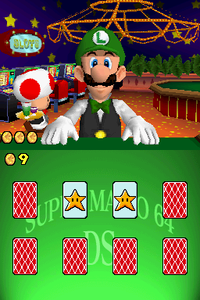Memory Match (Super Mario series): Difference between revisions
(Added infobox) |
m (Changed written numbers (e.g., "three", "twelve") to numerical format (e.g., 3, 12) for improved readability. Corrected misinformation regarding the number of cards served based on stars earned. Added details about the specific visuals on the cards, such as including Mario and Luigi cards when earning 5 Stars. Added pictures.) |
||
| Line 11: | Line 11: | ||
==Gameplay== | ==Gameplay== | ||
Betting | Betting 3 [[coin]]s, Luigi serves a group of 8 cards upside down, and the player must match them up with their twins. The symbols on Luigi's cards can be a [[Lakitu's Cloud|Cloud]], a [[Super Mushroom|Mushroom]], a [[Fire Flower]], or a [[Super Star|Star]]. By completing a challenge successfully, the player gains a double number of coins bet and receives a Star as a point. | ||
Earning 5 Stars makes Luigi serve 12 cards, adding a pair of [[Mario]] and [[Luigi]] cards. Earning 10 Stars makes him serve 16 cards, adding the [[Goomba]] and [[Bowser]] cards, and earning 15 Stars or more makes him serve 20 cards, adding the [[Boo]] and [[Yoshi]] cards. If the player taps two different cards, a coin is given to Luigi from the bet number, causing the likely loss of a Star if Luigi takes all these coins. If the player loses all of the money to bet, the [[Game Over|minigame ends]]. | |||
In multiplayer, there are 20 cards. The player who goes first is chosen randomly. The players go in order. If the cards a player taps match, the player earns two [[point]]s and gets to go again until they are wrong. Once all the cards are gone, the player with the most points wins. | In multiplayer, there are 20 cards. The player who goes first is chosen randomly. The players go in order. If the cards a player taps match, the player earns two [[point]]s and gets to go again until they are wrong. Once all the cards are gone, the player with the most points wins. | ||
<gallery widths=200px> | |||
NSMB_Memory_Match_Cards1.png|Cards available in the Memory Match minigame between 0 and 5 stars | |||
NSMB_Memory_Match_Cards2.png|Cards available in the Memory Match minigame between 5 and 9 stars | |||
NSMB_Memory_Match_Cards3.png|Cards available in the Memory Match minigame between 10 and 14 stars | |||
NSMB_Memory_Match_Cards4.png|Cards available in the Memory Match minigame from 15 stars and beyond | |||
</gallery> | |||
==In-game instructions== | ==In-game instructions== | ||
Revision as of 08:24, September 12, 2024
| Memory Match | |||
|---|---|---|---|
 The minigame in Super Mario 64 DS | |||
| Appears in | Super Mario 64 DS New Super Mario Bros. | ||
| Type | Luigi's minigame (Super Mario 64 DS) Table minigame (New Super Mario Bros.) | ||
| |||
Memory Match is one of Luigi's minigames in Super Mario 64 DS and a Table minigame in New Super Mario Bros. This minigame plays identically to the real-world card game Concentration.
A harder version of this minigame called Memory Master is exclusive to Super Mario 64 DS.
Gameplay
Betting 3 coins, Luigi serves a group of 8 cards upside down, and the player must match them up with their twins. The symbols on Luigi's cards can be a Cloud, a Mushroom, a Fire Flower, or a Star. By completing a challenge successfully, the player gains a double number of coins bet and receives a Star as a point. Earning 5 Stars makes Luigi serve 12 cards, adding a pair of Mario and Luigi cards. Earning 10 Stars makes him serve 16 cards, adding the Goomba and Bowser cards, and earning 15 Stars or more makes him serve 20 cards, adding the Boo and Yoshi cards. If the player taps two different cards, a coin is given to Luigi from the bet number, causing the likely loss of a Star if Luigi takes all these coins. If the player loses all of the money to bet, the minigame ends.
In multiplayer, there are 20 cards. The player who goes first is chosen randomly. The players go in order. If the cards a player taps match, the player earns two points and gets to go again until they are wrong. Once all the cards are gone, the player with the most points wins.
- NSMB Memory Match Cards1.png
Cards available in the Memory Match minigame between 0 and 5 stars
- NSMB Memory Match Cards2.png
Cards available in the Memory Match minigame between 5 and 9 stars
- NSMB Memory Match Cards3.png
Cards available in the Memory Match minigame between 10 and 14 stars
- NSMB Memory Match Cards4.png
Cards available in the Memory Match minigame from 15 stars and beyond
In-game instructions
- Super Mario 64 DS: "Pick two matching cards to make them disappear. Clear all the cards to win."
- New Super Mario Bros.
- Single player: "Pick two matching cards to make them disappear. Clear all the cards to win. If you make three mistakes, Luigi wins."
- Multiplayer: "Take turns choosing cards. If you find two matching cards, you get to keep them. Which of you has the best memory?"
Names in other languages
| Language | Name | Meaning | Notes |
|---|---|---|---|
| Japanese | ルイージのしんけいすいじゃく[?] Ruīji no Shinkei Suijaku |
Luigi's Concentration Game | |
| Chinese | 记忆测试[1][2] Jìyì Cèshì |
Memory Test | |
| French | Mémorisation[?] | Memorisation | |
| German | Gedächtnistraining[?] | Memory Training | |
| Italian | Accoppiata vincente[?] | Paired winning | |
| Korean | 루이지의 같은 그림 찾기[?] Ruiji ui gateun grim chatgi |
Luigi's Concentration Game | |
| Spanish | Test de Luigi[?] | Luigi's Test |